It seems we can’t find what you’re looking for. Perhaps searching can help.
Sign Up for newsletter!
Subscribe to get the latest eBook!
Hotline






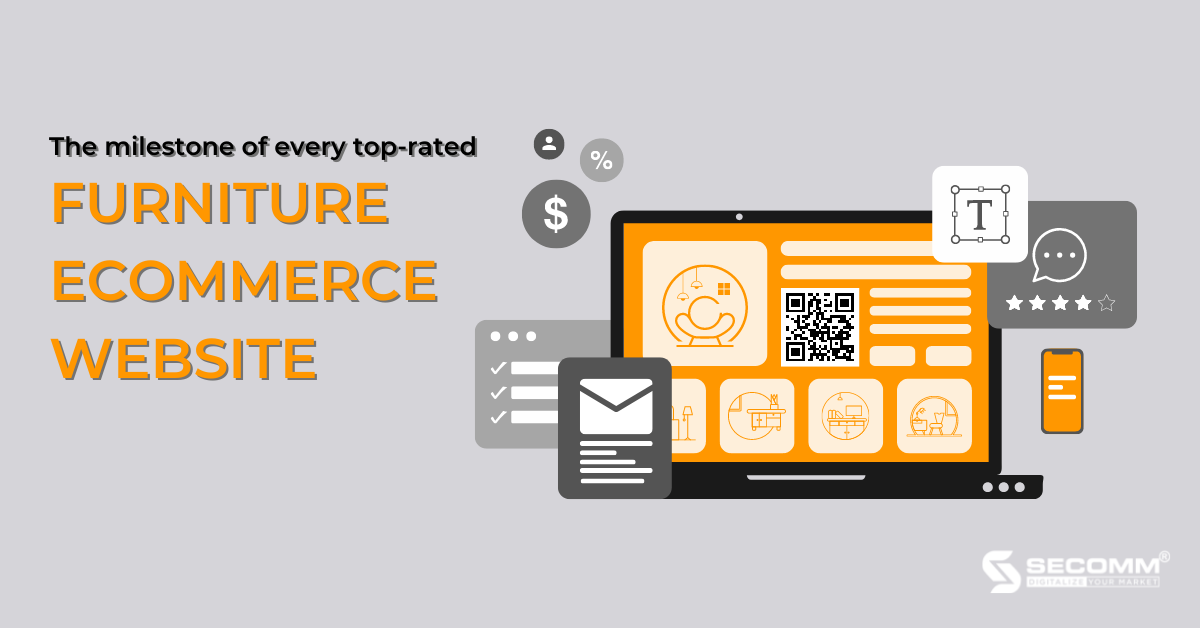
In the context of the Covid-19 pandemic, which is seen as an “obstacle” to the business activities of most businesses, eCommerce is emerging as an efficient way to enable Vietnamese furniture businesses to participate in the typical “playground” of global digital transformation.
At the same time, it is a pressing solution for furniture products to be consumed easily and accessible to many potential customers.
Therefore, the first wise step furniture brands have been hurrying to do in order to fast access the market is developing an eCommerce website. However, this difficult path calls for a significant investment of time and energy.
With years of expertise supporting several companies, SECOMM has developed a thorough process for developing a successful eCommerce website exclusively for the furniture sector.
The Covid-19 pandemic’s convoluted dynamics made travel challenging, which led to a necessity and urgency that resulted in the explosion of global eCommerce. At that point, internet buying and selling, which is more practical, takes the place of on-the-spot buying and selling.
Global eCommerce sales will rise from 15% in 2019 to 21% in 2021 and then continue to rise to 22% in 2022, according to Morgan Stanley. eCommerce will likely continue to have a large surplus. The market is established, and its growth rate might rise from its current level of 3.3 trillion USD to 5.6 trillion USD in 2026 as a result of significant company penetration in all industries worldwide.
In Vietnam alone, many service sectors had negative growth as a result of the Covid-19 outbreak, although the eCommerce market continued to grow steadily. In particular, the sector for wholesale and retail fell by 0.21%, transportation and warehousing fell by 5.02%, and that for lodging and food services fell by 20.81% in comparison to 2020.
In contrast to that doom, eCommerce has consistently grown at a pace of 16%, with retail sales reaching $13.7 billion USD in 2021. Additionally, the proportion of eCommerce retail sales in all retail consumer goods and services nationally reached 7%, up 27% from the same period in 2020. (Vietnam eCommerce White Paper in 2022).
Because of this, even if the epidemic is now under control and customers are beginning to purchase again in stores, expectations about the potential and rapid growth of the post-Covid eCommerce business are well-founded. The furniture business will not be the only one promoted to extraordinary growth from that point on.
According to Forbes, furniture and building materials have experienced the biggest growth in eCommerce sales during the past two years of the epidemic, with a cumulative growth rate of more than 200% over the year prior to the pandemic, 2019. The category of furniture and home appliances likewise experienced a remarkable cumulative gain of more than 66% compared to the same time in 2019.
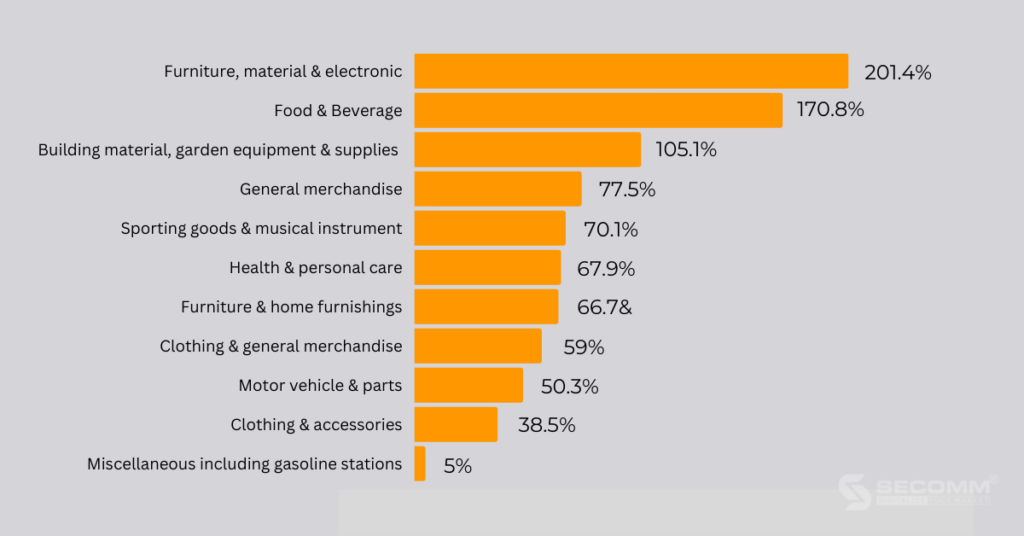
Recent findings made by Maddyness include the following intriguing details:
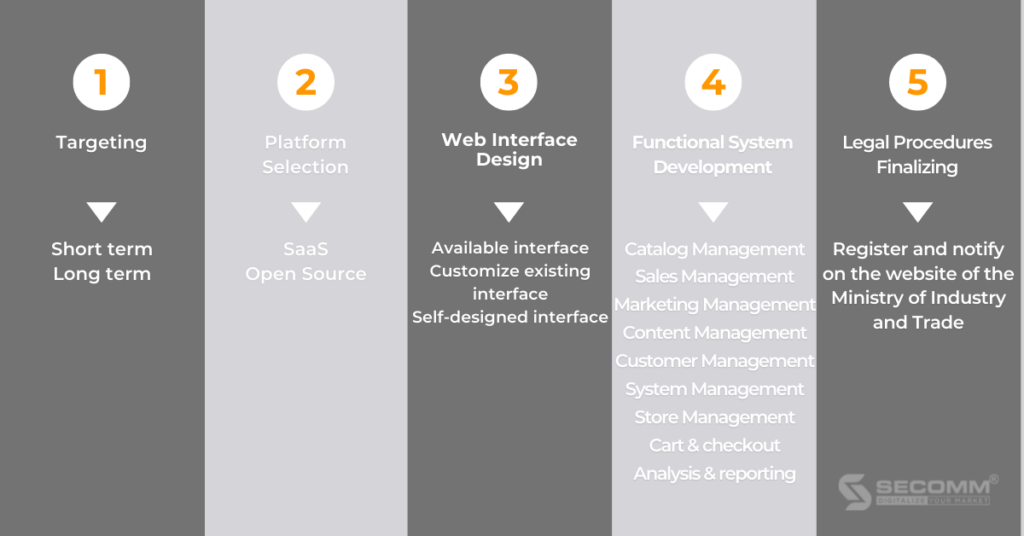
The very first thing that furniture businesses need to do is to determine their short-term and long-term goals and priorities before starting to develop an eCommerce website.
To accomplish the anticipated revenue increase in the short term, firms should place a priority on promoting marketing activities, tracking and analyzing customer behaviour, and assessing the efficacy of marketing initiatives. Furthermore, user experience is a crucial consideration that furniture companies must have in mind while advertising eCommerce.
Long-term objectives for firms could include raising brand awareness and coverage as well as evaluating the viability of individual items on online marketplaces. Effective marketing campaigns are also one of the long-term objectives that firms should take into consideration if they want to increase their online consumer base.
Businesses can take a lot of advice from specialized eCommerce implementation consulting units with a lot of experience in consulting a long-term roadmap to get the right list and priority of goals for both this period and beyond since they currently have little data to analyze and evaluate for the entire process.
There are currently two categories of platforms available on the market that enable the development of expert eCommerce websites and are highly well-liked, namely SaaS platforms and Open-source platforms. When used to create eCommerce for the furniture sector, these two types of platforms will each have the following advantages and disadvantages:
A service-based software application distribution mechanism for eCommerce commercial purposes is the simplest definition of a SaaS platform. To put it another way, the service provider develops and maintains software to aid in the creation of an eCommerce website, and the firm pays a set fee to use this service.
With SaaS platforms, the provider will own and manage the source code and data because the complete enterprise website system is hosted on the provider’s server. This means that the service provider will be in charge of handling and resolving technical issues that arise during the implementation of eCommerce by businesses.
Popular SaaS platforms are especially favored by businesses today, such as Haravan, Shopify, BigCommerce, etc.
Some of the advantages of the SaaS platform include:
The leading furniture enterprises in Vietnam using the SaaS platforms to build eCommerce websites include
However, there are still several drawbacks to the SaaS platform that should be taken into account:
Open Source Platform is software with generally available source code that enables customers to obtain, upgrade, and modify additional features required for eCommerce company needs. Instead of being produced by a single corporation, open-source platforms are frequently created by a community of developers.
In addition, because it offers extensive customization options, this platform will be perfect for creating sophisticated eCommerce website systems tailored to a variety of industries, including the furniture industry.
This means that in order to efficiently administer the website and handle technological issues, firms either need to work with expert eCommerce website builders or develop a team of highly qualified internal workers.
In Vietnam, the most popular Open Source platforms to mention are Magento, OpenCart, WooCommerce (WordPress Plugin), etc.
The outstanding advantages of the Open-Source platform:
The following well-known Vietnamese furniture companies are developing their online stores using the Open Source platform:
The disadvantages worth noting when implementing eCommerce with the Open Source platform:
Businesses should focus on making sure that the website interface conforms to UI/UX standards, clearly displays the brand’s distinctive characteristics and those of the furniture industry, and is synchronous in terms of product presentation and layout when designing the interface of an eCommerce website.
So, businesses can select one of the three methods listed below to create the website interface:
Firms should typically only use methods 1 or 2 at this point because the functional system is still in its early phases and easily found in the available interface.
In phase 1, businesses can prioritize the development of a system of basic functions needed for a complete furniture eCommerce website, specifically as follows:
The final step of building a basic eCommerce website is completing the necessary legal procedures for the website to be allowed to operate legally. Businesses can follow the simple registration steps as instructed at the eCommerce Management Portal.
This is a mandatory requirement of the Ministry of Industry and Trade for every individual or organization that owns an eCommerce website to sell goods and to perform the registration/notification obligation on time.
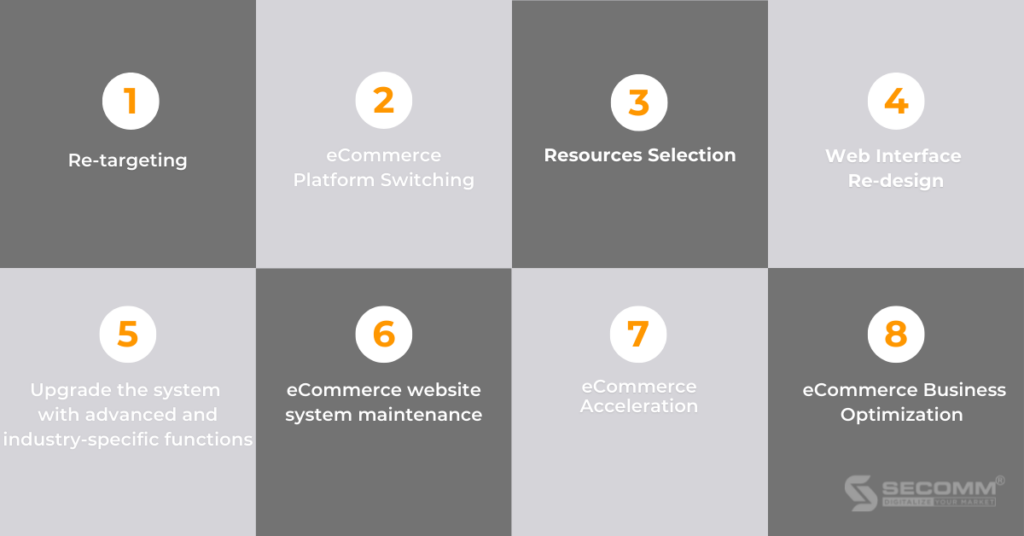
Along the journey of business development that comes with ever-changing consumer needs, business goals and strategies need to be adjusted and reconfigured to fit the current business landscape In addition, at this stage, businesses also have problems, data, and insights about their online users, so setting goals will be easy.
In the short term, companies can use efficient marketing techniques to locate and connect with a wider pool of new potential clients online and boost online sales.
In the long run, market sector expansion and building a loyal customer base might be objectives for furniture eCommerce firms. In the second step of the trip to create a successful eCommerce website, businesses will simply develop and implement marketing strategies in accordance with the product features and individual directions of each business by identifying the target market segment.
Businesses must prioritize thinking about the time and cost of investing in a furniture eCommerce website system in addition to short- and long-term objectives because at this stage, the cost and investment budget will frequently be substantial and much higher than the above basic building phase.
If a company decides to use the SaaS platform to create an internal eCommerce website in the first stage, it will not be able to satisfy the expectations for development and expansion in the second stage due to its restricted customization and capability. Businesses should now convert to an open-source platform with well-known names worth considering, such as Magento, WooCommerce, Ziel Commerce, etc., in order to create an advanced furniture eCommerce website.
Following are some criteria for furniture companies to take into account when selecting an Open Source platform:
Businesses should focus on the costs associated with switching from a SaaS platform to an Open Source platform, the time required for staff to adapt to the new platform, the risk of data loss, and any errors that may occur during the changeover.
Resource selection for the deployment of an advanced system must be made with considerable thought, in contrast to the basic system development phase. Businesses have the option of creating an internal team or hiring a professional website developer to assist them.
The business will hire and train skilled and specialized IT people on the selected platform for internal team building which requires a lot of time and money, but it will improve resource management and control and actively adapt the development of the eCommerce website system in line with the original objective.
Businesses frequently consult several eCommerce website developers before choosing the finest one for their collaboration. The needs of the businesses for an eCommerce website will thus be satisfied as anticipated, the collaboration process will go smoothly, and the businesses will gain more expertise and experience in website development from that partner, which will provide them with directions consistent with the development trend of the furniture eCommerce industry.
These are the criteria that businesses should consider when choosing: In-depth knowledge and experience in eCommerce and the furniture industry; professional working team; clear and detailed working process; ability to quickly handle problems that arise during website construction.
Businesses are not required to update the website interface while switching platforms. However, the redesign of the website interface to fit the Open Source platform is now turning out to be a beneficial piece of advice given the new company development plan introduced concurrently with the implementation of eCommerce websites at a more advanced level.
Similar to the preceding period, companies have three alternatives for designing the user interfaces of their eCommerce websites: they can use the existing interface, customize it based on the existing interface, or create their own interface. To ensure the distinctiveness of the brand and the particularity of the furniture eCommerce industry, businesses should typically use methods 2 or 3 to develop the interface at this stage.
Businesses should concentrate on establishing a system of advanced and specific features of the furniture eCommerce industry to suit the new development phase, in addition to the basic functions that have been established for the eCommerce website system in the early stages.
Businesses may better grasp the challenges of implementing intense furniture eCommerce and provide solutions to address those challenges and fulfil the market’s rising expectations thanks to advanced and distinctive functions.
As a result, companies use AR technology to improve the consumer experience. While augmented reality (AR) technology is built on virtual reality (VR) technology, it focuses on fusing the actual environment and digital data to give users the ability to view digital data in the physical world. The furniture eCommerce sector makes extensive use of this technology.
Customers now only need to download the company’s AR program, turn on the camera, and evaluate the product’s fit with the area of the house rather than physically going to the store to see the things and try them on to see whether they fit.
Customers’ buying experiences are improved and made more unique by augmented reality (AR) applications, which convert traditional marketing into interactive marketing. IKEA Place App, the furniture buying an app from “big man” IKEA, is a wonderful example because it offers clients a novel and engaging shopping experience.
Customers can use their smartphones to place and try out the more than 2,000 tables, chairs, sofas, shelves, and other household appliances in a real room, change the viewing angle, and zoom in and out. Also, the software will scale items to their true size with 98% accuracy.
A sophisticated eCommerce website system demands a great deal of experience and effort to operate and maintain. This is the procedure of continuously maintaining, updating, and upgrading the entire system to aid firms in foreseeing and resolving problems (for example, sudden increase in traffic from the promotions that stimulate shopping).
That supports sustained and persistent online sales growth, which is important for eCommerce businesses in general and furniture eCommerce in particular as they compete for a market share of this “pie,” which is “delicious” but can be challenging to consume.
Furniture eCommerce enterprises readily accomplish growth above and beyond expectations by putting into practice efficient business and marketing strategies.
Therefore, the entire process—from planning through implementation—must be structured with effective, practical solutions that have been demonstrated to work. Implementing Omnichannel, eCommerce Marketing, and SEO optimization are some suggested methods for eCommerce enterprises to accelerate growth.
The journey of developing an eCommerce website ends with measuring, analyzing, and optimizing eCommerce business activities.
Businesses can use analytics tools such as Google Analytics, Google Tag Manager, Facebook Pixel, etc., to track, update and measure website performance metrics as well as the effectiveness of marketing campaigns.
From there, the eCommerce business strategy for the next stage of development will be carefully and methodically planned thanks to clear and detailed reports & analysis.
The journey of developing an eCommerce website for the furniture sector is divided into two phases with clear step-by-step instructions. Businesses will, however, be able to go in one of two strategies, each with its own advantages and drawbacks, depending on the platform they decide to use for the first phase.
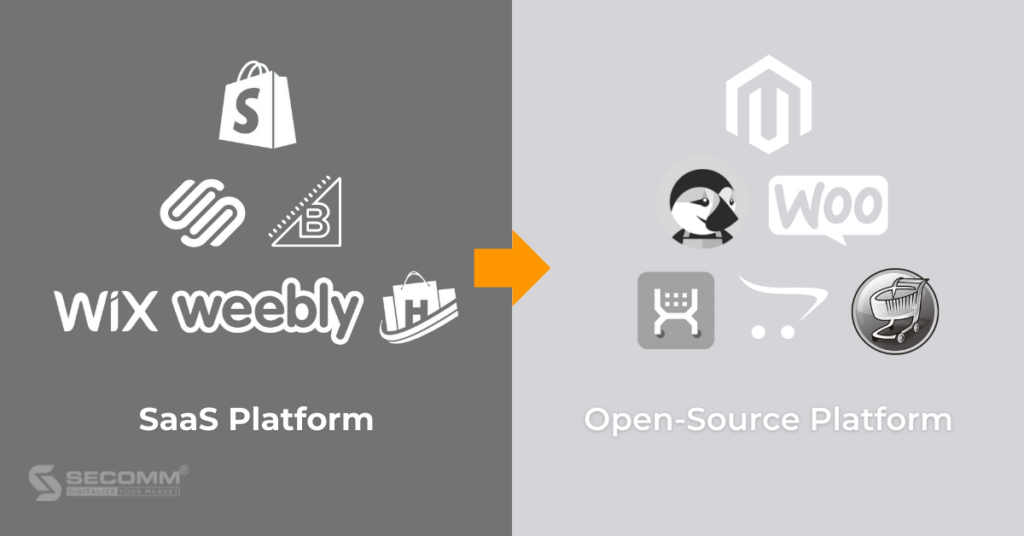
The quick deployment time of a SaaS platform is one of its benefits. In order to swiftly enter the market and create a simple website system, enterprises can pick SaaS at an early stage. Businesses will evaluate the furniture items’ suitability for the eCommerce market’s demands as well as their influence on upcoming consumer trends there.
The switch to an open-source platform will make it more reasonable to extend and develop a specialized website system in order to raise brand awareness and increase online sales over a period of time long enough for businesses to become accustomed to and adapt to the ever-changing market.
Businesses will save a lot of money by implementing eCommerce utilizing the SaaS platform early on as opposed to developing a website using the Open Source platform. Businesses can use that capital to invest in other activities, such as marketing strategy, which is one of the crucial components for the success of any company, not only furniture companies, because the initial cost of a SaaS platform is typically not too expensive.
The ability to conduct business while gaining knowledge and expertise in technology and how to efficiently implement eCommerce is another advantage of this approach to developing an eCommerce website. In general, running a business is challenging, and operating an eCommerce firm is even more challenging in today’s continuously shifting market and technologically complicated and varied trends.
As a result, acquiring knowledge and real-world experience is both a necessary and a sufficient condition for businesses to achieve extraordinary success. Because a SaaS platform is simple to use and doesn’t require a lot of technical knowledge, choosing one to deploy in the early stages can help businesses become comfortable with eCommerce terminology, concepts, and how to build a website at a basic level.
Due to the complex requirements of an extensive eCommerce website system, businesses will need support from a strong IT team during the second stage of switching to the Open Source platform. The collaborators and partners will then complement each other’s knowledge and experience at that point.
As was stated in the introduction to the platform, the fundamental functional system of SaaS platforms will not be sufficient to meet the needs of the eCommerce business at the growth and scalability stage.
Therefore, whether you like it or not at this moment, you must switch to the Open Source platform in order for the eCommerce system’s expansion and scalability goals to continue to be successfully implemented.
When adopting this approach for the process of developing and perfecting the website system, eCommerce firms in general, and furniture enterprises, in particular, should pay close attention to this first drawback.
Businesses will significantly reduce the initial cost of the working process by using this strategy. The initial benefit, though, later turns into a detriment in the long run. In addition to the ongoing platform usage fees that companies must pay for the SaaS platform, additional service costs are also significant enough to complicate and make cash flow management challenging to manage.
Because of the characteristic of the SaaS platform, customers are not permitted to keep the source code and data when switching platforms, thus enterprises must once again pay the initial development costs after the stage of moving to the Open Source platform. Additionally, the cost of development using an Open Source platform is rather costly, ranging between $30,000 and $50,000 on average.
Additionally, firms will “headache” from the sunk costs associated with switching platforms. The cost of staff training is seen as an additional expense rather than a true investment if you are accustomed to the new system, especially at a time when the economy is anticipated to rebound following COVID-19.
Furthermore, it is easy to make mistakes during the platform shift that result in the loss of crucial firm data, such as data that is closely tied to financial matters. With all the hazards mentioned, managing cash flow and maintaining balance is still a challenging issue that obviously affects furniture companies’ eCommerce business strategies.
Strategy no. 1 will be appropriate for startups or SMEs learning about eCommerce and entering the market safely based on the pros and disadvantages highlighted.
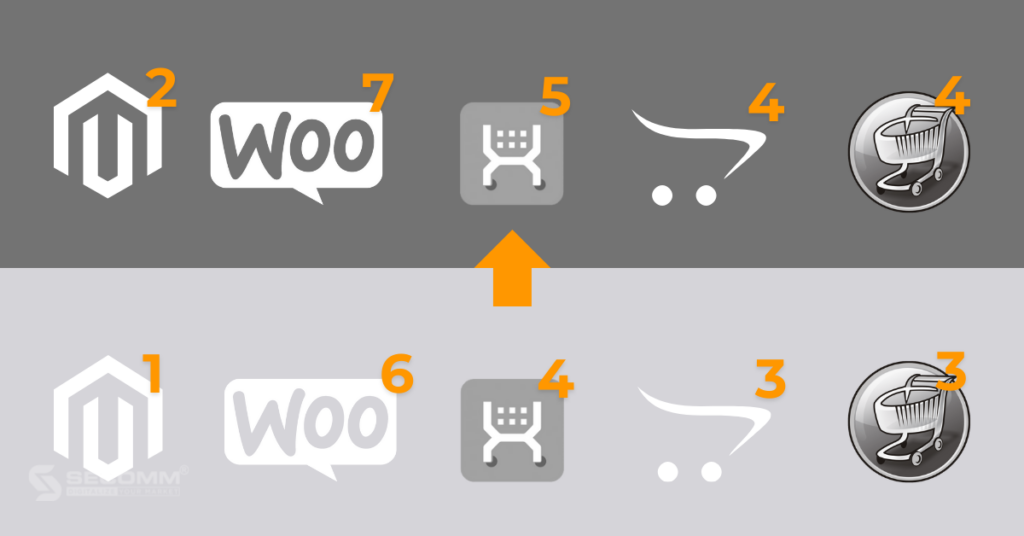
With the second strategy, companies develop eCommerce websites on the Open Source platform from the very beginning. Due to the smooth website development process, businesses merely need to gradually improve their functional systems in line with their growth and scale rather than switching platforms.
Long-term cost savings for enterprises are made possible by this seamlessness. In which, addition to saving money by avoiding the cost of starting over when switching platforms as a first strategy, firms also minimize the danger of data loss and spend less time and money training staff to use the brand-new platform.
The second approach, on the other hand, aids firms in laying a strong foundation right away with a professionally designed and smooth eCommerce website system and a team of essential technical personnel who are knowledgeable and well-trained from the start.
Similar to the first strategy, despite its notable benefits, the second one still has some drawbacks that companies should take into account before implementing furniture eCommerce. The market penetration will be slowed down if Open Source is chosen for the first phase of the deployment process.
All of the website’s features will be designed from the ground up because it will be built on an open-source platform. It takes the team a lot of effort, time, and brainpower to accomplish the entire process, which often takes between three months and a year.
Therefore, the lengthy implementation period is a drawback that slows down market entry, increasing the risk of falling behind in the competitive eCommerce race. Correspondingly, firms will have to pay a considerably larger upfront development fee than they would for a SaaS platform.
When companies must invest a significant sum of money in a platform upfront yet are unsure of its viability and effectiveness for adopting eCommerce, there is a risk involved.
From a business perspective, this drawback is viewed as an opportunity cost, meaning that while this strategy offers firms enormous long-term rewards, it also comes with trade-offs that present difficulties in the short term.
To meet growth and scalability objectives as well as avoid potential risks from switching platforms mentioned in advance, or to make the process of eCommerce implementation simple and efficient.
Therefore, it is incredibly appropriate to invest time and money in starting from scratch with Open Source.
The second approach can be appropriate for firms with a variety of business models, including B2B, B2C, and B2B2C, when the advantages and downsides are carefully thought.
With the high growth rate of Vietnam’s economy, eCommerce makes a significant contribution to promoting the flow of goods and services, supporting small and medium enterprises, especially those in the furniture sector, to seek effective business opportunities in the context of deep integration and the spread of the 4th Industrial Revolution.
Moreover, a qualified eCommerce website serves as a “bridge” for furniture companies to achieve that integration objective. However, building a comprehensive, modern, and professional eCommerce website is never simple and necessitates a significant financial investment.
The journey to develop an eCommerce website is described above in great detail by SECOMM with a few extra tips that furniture businesses can refer to shorten your own planning.
With many years of experience in successfully implementing eCommerce for many customers in many countries in recent years, SECOMM understands the difficulties and challenges in the process of implementing an interior eCommerce website.
Contact SECOMM today for free support and advice.
 2
2
 4,288
4,288
 1
1
 1
1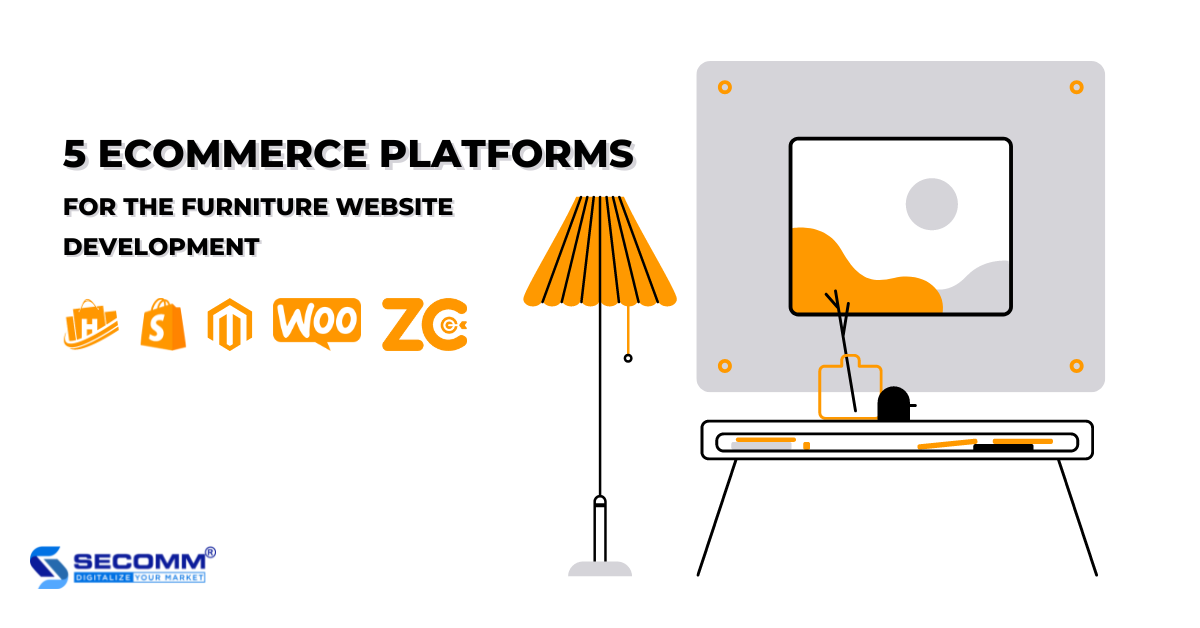
eCommerce is currently developing into a fresh and promising sales channel for furniture companies in addition to the traditional sales channel. Businesses must work hard to sustain and achieve breakthrough growth through eCommerce platforms, though.
As a result, numerous furniture companies started developing online furniture business websites and found surprising success, such Sieu Thi Noi That va Trang Tri Baya, Nha Xinh, Cozy, or Noi Phat Hoa Phat.
These websites’ success can be attributed to their early selection of an adequate and suitable eCommerce platform. Which platforms are appropriate for the furniture industry, then?
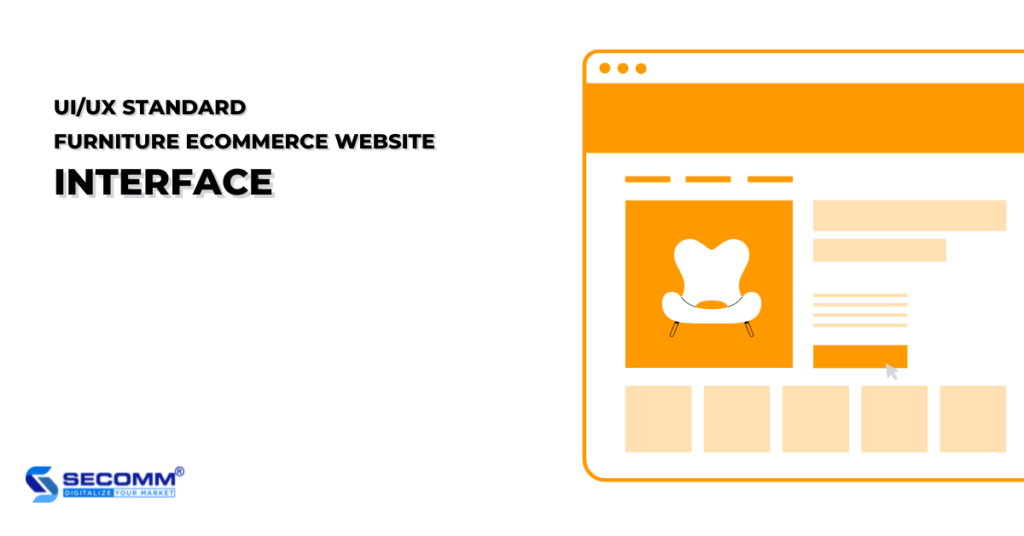
The first criterion businesses set when developing an eCommerce website is a standard UI / UX interface, friendly to users who enjoy shopping for furniture online and other home goods to increase customer interaction.
Similar to eCommerce websites in other sectors like fashion, electronics, etc., websites in the furniture sector must feature stunning and high-quality photographs and videos.
This makes it simpler for companies to communicate product information to customers, especially with banner advertisements that have an easy-to-use interface and a pleasing style that will pique shoppers’ interests.
Businesses also need to consider other concerns including call-to-action button placement, cross-device compatibility, and layout designs that display a range of product designs from the navigation bar to page-by-page details.

Furniture firms need a functional system from basic to advanced to fully meet consumers’ buying expectations and maximize the user experience. This system should include:
Businesses also need to develop some additional specialized features to address the furniture industry’s “own challenge,” such as:
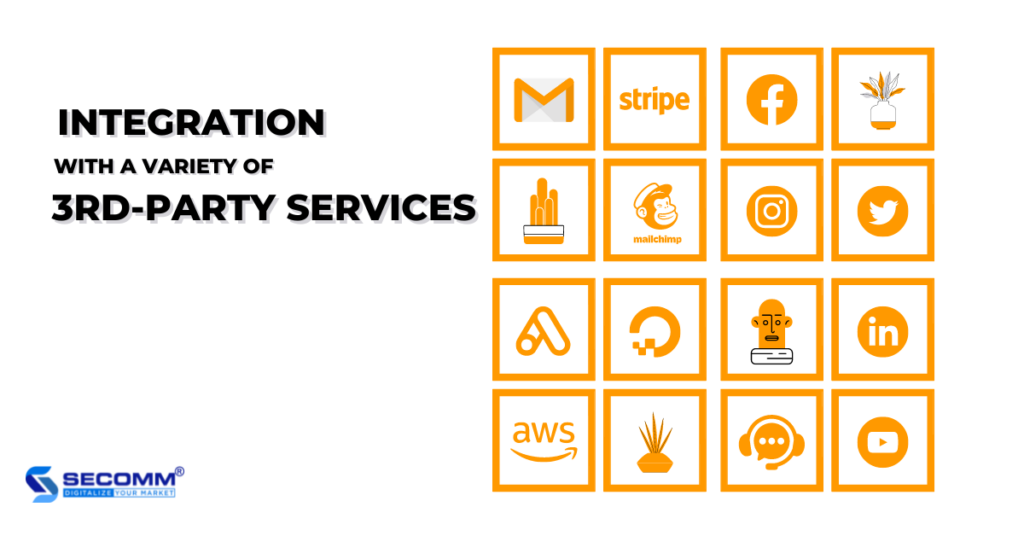
Furniture businesses frequently integrate a range of payment options, shipping services, management software, and business analysis tools to optimize eCommerce business systems in order to provide customers with a comprehensive shopping experience.
Some popular payment methods businesses can integrate on the website to diversify payment methods to help customers have many choices such as card payment; eWallet; payment gateways.
Businesses might take into consideration software like ERP (SAP, Salesforce, Oracle), among others, when integrating back-office administration and operation software.
Finally, incorporating BI tools like Tableau, Looker, etc. will aid in the long-term analysis of business plans.

Businesses that are just starting to use eCommerce won’t concentrate on the website’s scalability in the future because platforms that provide this feature are sometimes hard to find. But tactically, spending money on a platform that facilitates this function will provide organizations an advantage over rivals in the market.
These aid furniture companies in making necessary adjustments, creating new features, and expanding their online systems to support several stores, languages, and currencies in the future.
Haravan was founded in 2014 and is a very popular and popular eCommerce deployment platform in the Vietnam market with a variety of solutions for businesses and individual sellers.
Pros:
Cons:
=> Rating: 2/4
Haravan is suitable for start-up furniture businesses or SMEs (small and medium-sized enterprises) with operations mainly in Vietnam.
Shopify is a popular SaaS platform in the world that provides a variety of solutions for businesses of all sizes to successfully build eCommerce websites.
Pros:
Cons:
=> Rating: 2/4
Shopify is considered suitable for start-ups or SMEs with global operations.
ZielCommerce is an eCommerce platform with ready-made solutions specialized for the furniture industry.
Pros:
Cons:
=> Rating: 3/4
ZielCommerce will be the optimal choice for B2B, and B2C furniture businesses to deploy eCommerce websites or build mobile apps. However, this platform is not really popular in the Vietnamese market but is especially favored by foreign furniture retailers such as Frampo, Zeyka, etc.
WooCommerce is a free WordPress plugin that allows businesses to transform a regular WordPress website into a professional eCommerce website with full features and easy customization with just a few simple steps.
Pros:
Cons:
=> Rating: 3/4
WooCommerce will be suitable for furniture businesses who are familiar with the WordPress platform and want to develop an eCommerce system.
Magento is a popular open-source commerce platform in the field of eCommerce, with nearly 200,000 websites in use. Currently, Magento has 2 versions: Magento Open Source (free), and Magento Commerce (paid).
Pros:
Cons:
=> Rating: 4/4
Magento is appropriate for a range of furniture business types, including B2B, B2C, and B2B2C, as well as for various business sizes, including start-ups, SMEs, and major companies. However, large organizations use Magento because it is frequently relatively expensive to deploy.
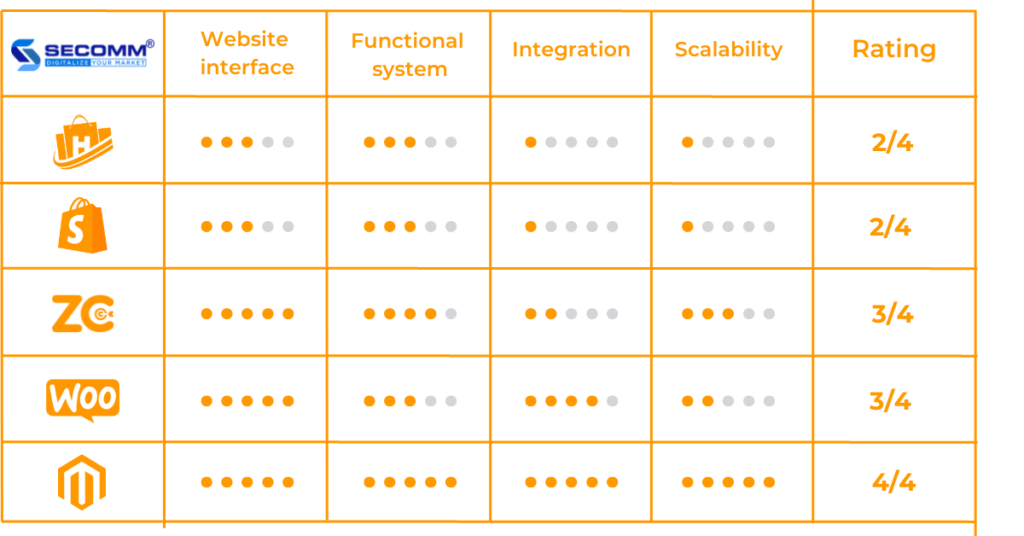
Choosing the right platform is an extremely important first step when building an interior eCommerce website. Choosing the right eCommerce platform will help businesses save budget and time to build a website while increasing competitive advantage and sustainable growth. On the contrary, when choosing the wrong platform, it will cost businesses a lot of time and budget to deploy and switch platforms many times. Therefore, businesses need to consider the goals and problems in the current model to be able to choose the most suitable platform.
With many years of experience in successfully implementing eCommerce for many customers in many countries, SECOMM specializes in providing consulting services with comprehensive and professional eCommerce implementation solutions.
Contact SECOMM today for free support and advice.
 2
2
 4,943
4,943
 0
0
 1
1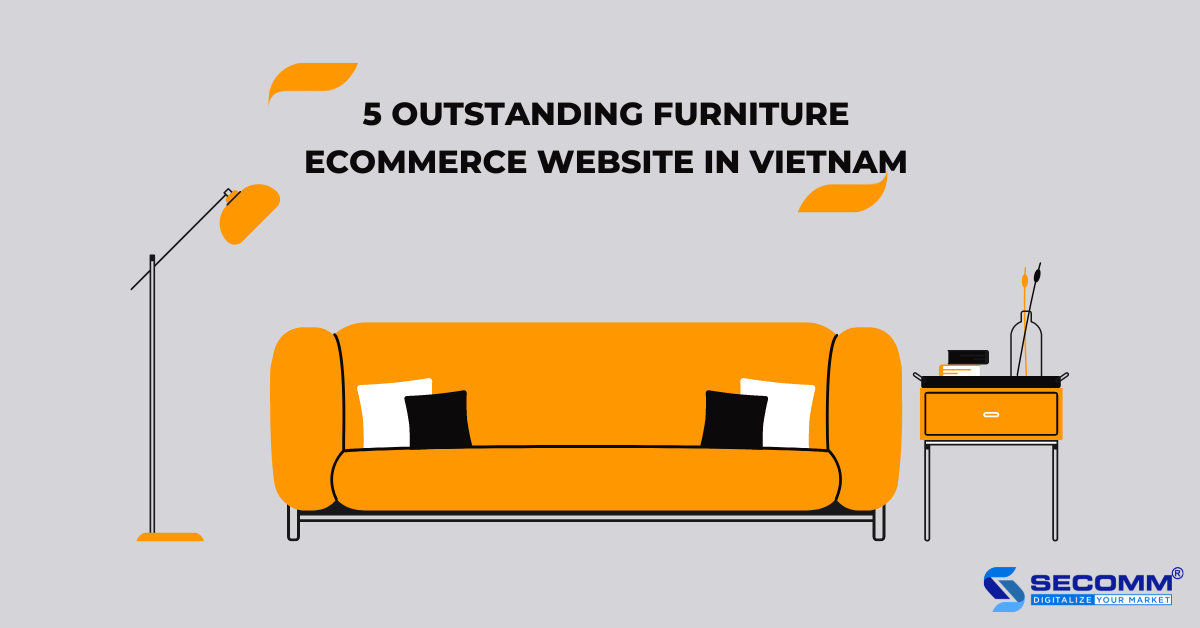
Businesses may quickly detect a change in consumer behavior throughout the course of the pandemic as online purchasing steadily expands from basic necessities like food and medicine to a variety of other industries like fashion, wine, and furniture.
Also, customers’ awareness of a pleasant, modern, and healthy lifestyle has grown dramatically, which has given the furniture business a chance to go online and serve as a catalyst for Vietnamese eCommerce furniture to see breakthrough growth.
Realizing the great potential of this field, Vietnamese furniture enterprises have been embarking on building an eCommerce website system, which is considered an important factor leading to the success of this modern business trend.
Initially founded in 2006 under the name Sieu Thi Noi That Uma, the business has only recently (in 2019) changed its name to Sieu Thi Noi That Trang Tri Baya.
Although the brand’s name has changed, its essential values haven’t. It still offers clients high-quality furniture with a clean, sophisticated, trendy design in a neutral tone, and each piece is beautiful in its own right.
Thanks to the wise investment in developing a professional eCommerce website with the Magento open-source platform with an attractive and user-friendly interface, Baya’s website currently receives more than 100,000 visits each month.
In order to give clients the best eCommerce experience, this furniture manufacturer is constantly improving the system.
In addition, the company demonstrated its awareness of market trends by creating an app called My Baya with a QR payment method and positioning it as one of the primary categories on an eCommerce website to draw consumers’ attention to the website.
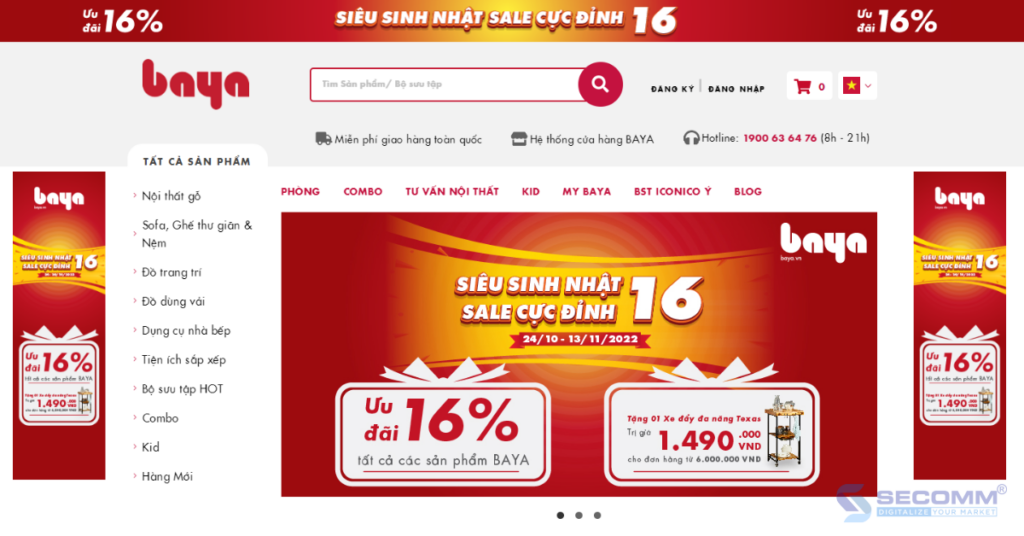
With nearly 30 years of market experience and a wide range of clients, Hoa Phat Furniture is one of the top furniture suppliers and manufacturers in Vietnam.
All of Hoa Phat’s items are designed with a contemporary, opulent, and refined aesthetic in mind. In addition to a business strategy that is flexibly adjusted to the changes in the market, the company fully exploits the potential of eCommerce by building a professional and well-organized website on the BigCommerce platform.
From there, businesses increase their coverage and brand awareness on the Internet and reach more customers thanks to effective marketing methods.
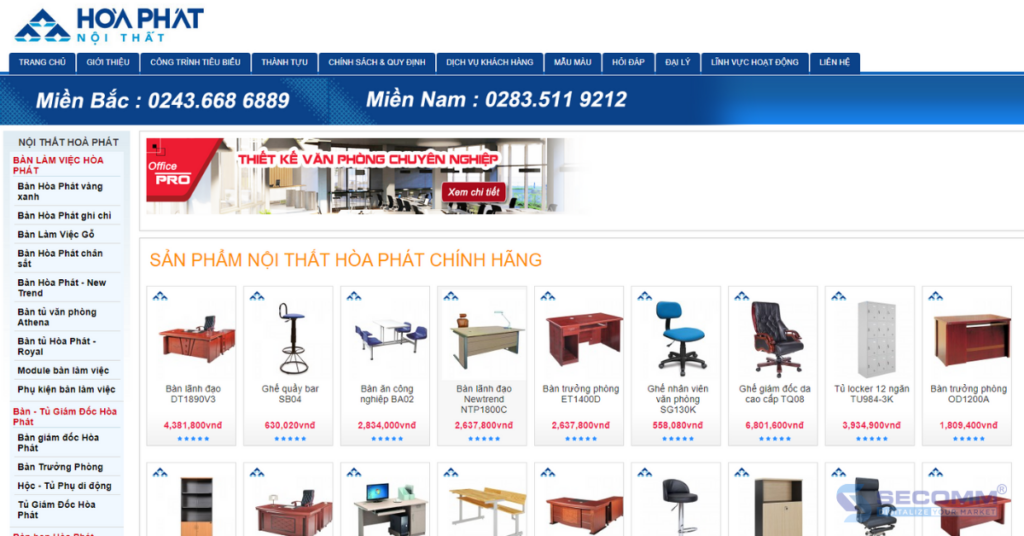
The Moho furniture brand was established in March 2020 and is a subsidiary of Savimex, a company with over 35 years of expertise in the production and export of furniture. In order to fulfill the goal of sustainable development, Moho has kept offering clients furniture goods with affordable pricing and quality in accordance with international standards.
With more than 50,000 monthly visitors and a popular Haravan platform, Moho’s eCommerce website is well-liked by customers for their online buying experience.
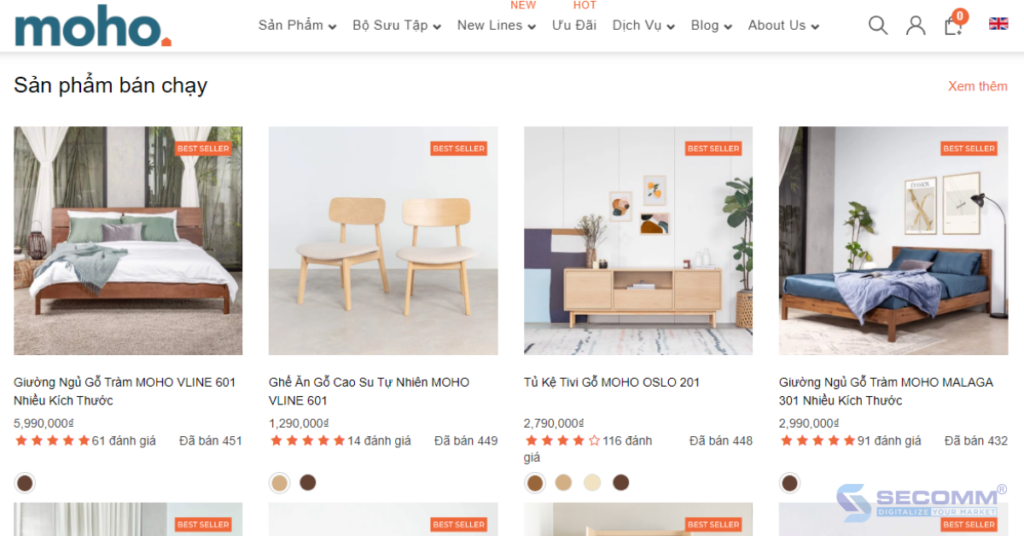
COZY is a famous furniture brand present in the market since 1995 with high-class Italian-style designs. All products distributed by COZY are subjected to quality checks. With more than 25 years of establishment and development, COZY is one of the leading prestigious units in Vietnam in importing furniture from high-end brands from Europe.
In order to increase sales channels and reach a large number of potential customers online, COZY invested in developing an eCommerce website using the Shopify platform in addition to the showroom system dispersed around the districts of Ho Chi Minh City.
Because of the website’s elegantly crafted, opulent, and smart user interface, it receives an astonishing 45,000 visitors each month.
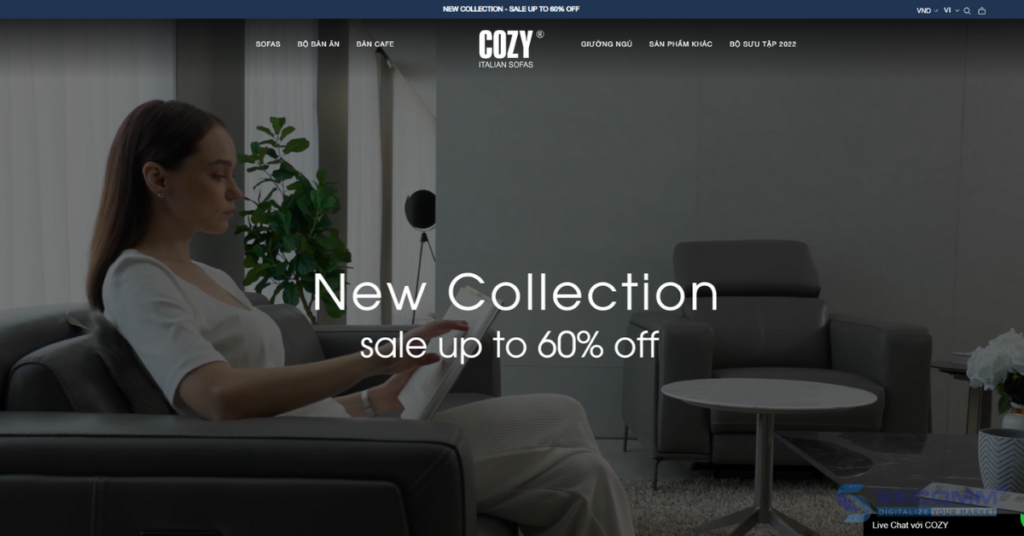
Nha Xinh chooses a simple and intimate interior design style for each of the company’s products. The WooCommerce platform’s straightforward and user-friendly design of Nha Xinh’s eCommerce website’s interface amply illustrates this.
Furthermore, Nha Xinh’s website uses 360-degree technology to enable buyers to experience the company’s interior items from a distance in an accurate manner, providing information and a complete price list for each item from every angle of the room and product.
The eCommerce website now receives more than 40,000 visitors each month because of its painstaking attention to every last detail.
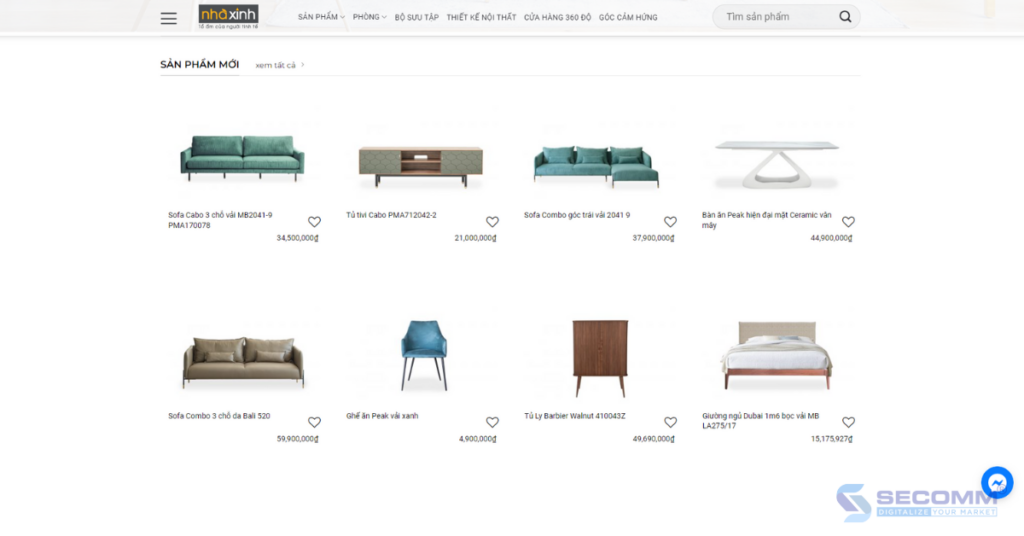
Customers can save a ton of time and money when shopping online, especially when purchasing furniture. However, there are a lot of potential hazards associated with this type of business, particularly with regard to product quality and information security, and safety during the shopping and payment processes.
The furniture eCommerce sites discussed in this blog post are well-known destinations that have been active on the market for a long time and have serviced and satiated the wide range and expanding needs of clients.
These companies demonstrate their efforts to create the technological infrastructure that will enhance customers’ online shopping experiences, and they take priority on the development of a professional, well-invested supply chain that will expedite shipments while maintaining the quality of the goods until they are received by the customer.
When Vietnamese furniture businesses launch their own fully-functional eCommerce websites, professionalism, adaptability, and speed are the key success criteria.
Nevertheless, in order for the furniture eCommerce firm to succeed, business managers must carefully and comprehensively take into account the growing client wants and the continuously shifting market trends.
In particular, the task is to lay out a solid and methodical company plan so that the best short- and long-term actions can be taken. Completing that difficult task will take a lot of time and resources. As a result, many furniture companies opt for a more straightforward approach to the issue, enlisting the assistance of a highly qualified and dependable unit.
With many years of experience in successfully implementing eCommerce for many customers in many countries, SECOMM specializes in providing consulting services with comprehensive and professional e-commerce implementation solutions. , repertoires.
Contact SECOMM today for free support and advice.
 2
2
 6,987
6,987
 0
0
 1
1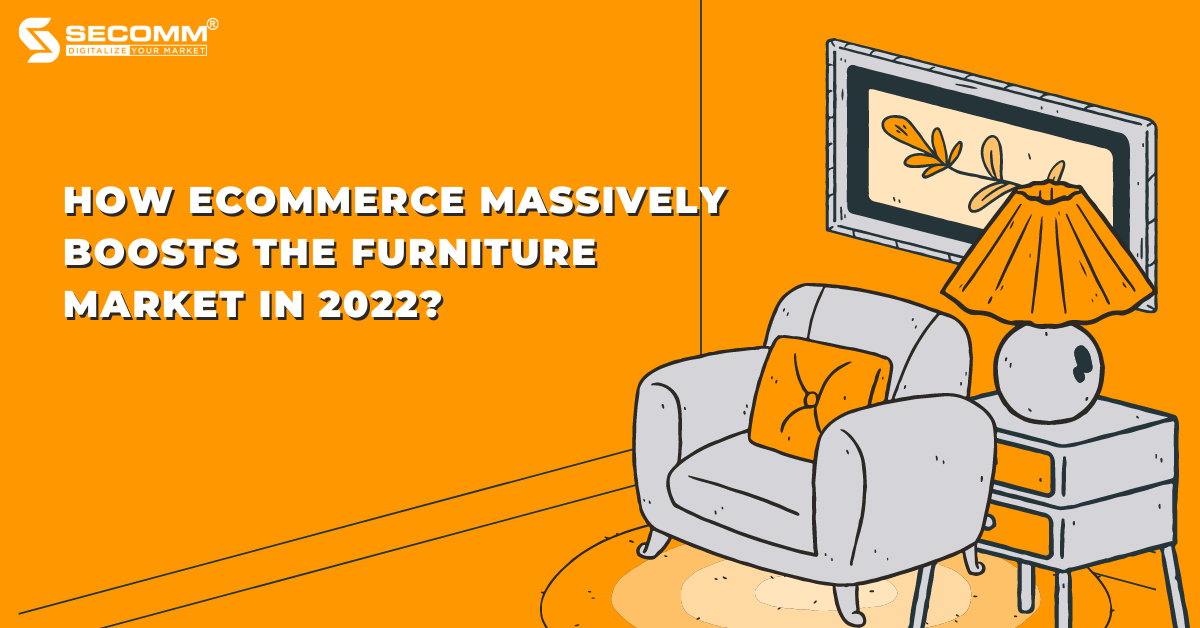
The desire for home furnishings and design among consumers has significantly increased as life gets better and better. The majority of consumers still prefer to choose and purchase products in physical stores and showrooms, but online furniture shopping is an increasing tendency. Additionally, the impact of the Covid-19 pandemic on consumer purchasing habits has changed how people purchase, which has greatly aided the development of the furniture eCommerce market.
BusinessWire estimates that the size of the furniture eCommerce market in 2021 was valued at USD 27.74 billion and that it would increase at a compound annual growth rate (CAGR) of 4.4% from 2022 to 2030 to reach USD 40.74 billion.
Recent findings made by Maddyness include the following intriguing details:
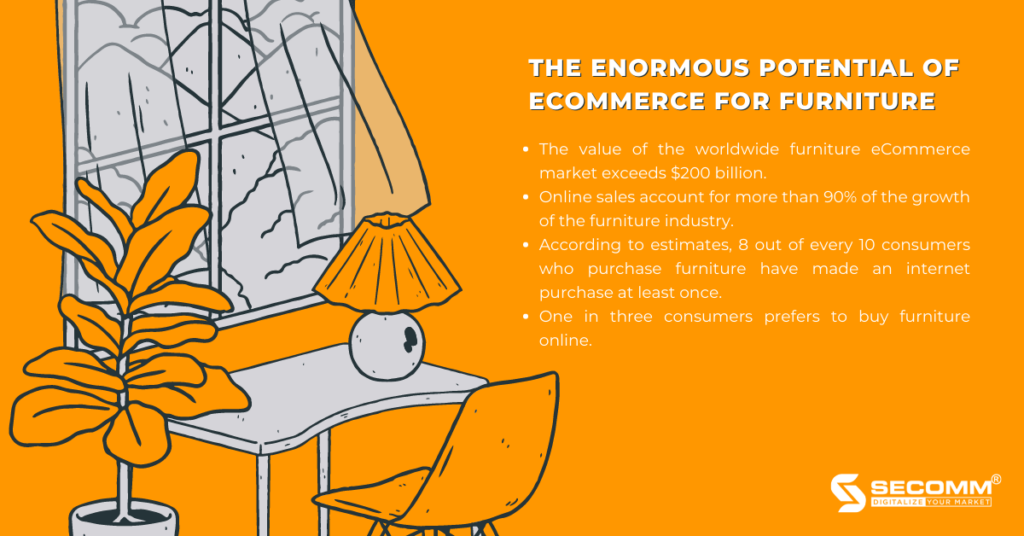
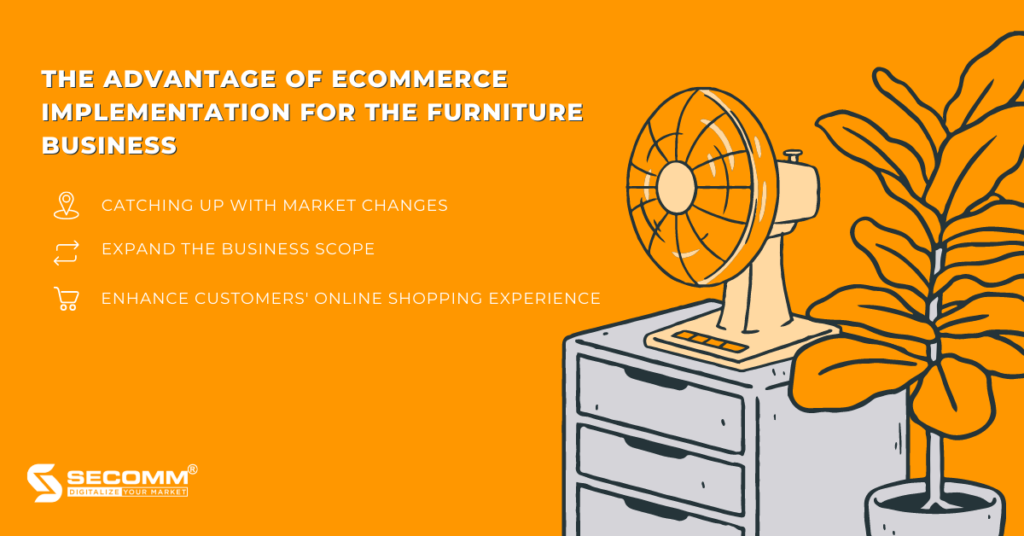
The furniture sector has experienced a significant decrease in sales over the past few pandemic years, along with many other industries.
People are compelled to reduce their social interactions during the social withdrawal period. They now spend more time working, living, entertaining, and teaching at home. In light of the unpredictable changes of the pandemic, the necessity to clean and renovate the dwelling has therefore substantially increased.
Due to limits on leaving the house, online shopping at the time had become not only a need but also an urgent method of purchasing in place of in-person purchases. That serves as the springboard that gives eCommerce its spectacular development and propels it into other industries like fashion, grocery, wine, and even furniture.
These two elements highlight the “cake’s” enormous potential and aid many furniture companies in realizing and swiftly implementing eCommerce for market revolution and sustainable development.
Due to the Internet’s rapid expansion and the burgeoning online shopping trend, which is gradually replacing traditional offline shopping, the adoption of eCommerce will benefit furniture manufacturers by providing a new sales channel and attracting a big number of potential clients (at stores, and showrooms).
eCommerce implementation will also help to broaden the market for businesses by improving the circumstances for marketing campaigns to be more successful.
When firms use technology to improve customer experience in eCommerce, furniture shopping will happen more quickly.
In the digital age, for instance, visual experiences from VR/AR technology, 3D product visualization, and 360-degree photography are very popular, gradually replacing in-store shopping while still being fully informed and realistic visualization of products, thereby increasing customer satisfaction during online shopping.
eCommerce enables businesses to quickly and effortlessly tailor the experience for customers by gathering, evaluating, and synthesizing the consumption behavior of each target group. Typically, this is done with the capabilities listed below: Products have seen, similar product recommendations, etc.
eCommerce provides clients with a seamless experience in addition to an intuitive one across a variety of channels, including social networks (Facebook, Instagram, Tiktok, Zalo, etc.), eCommerce platforms (Shopee, Lazada, Tiki, Sendo, etc.), eCommerce websites, mobile apps, etc.
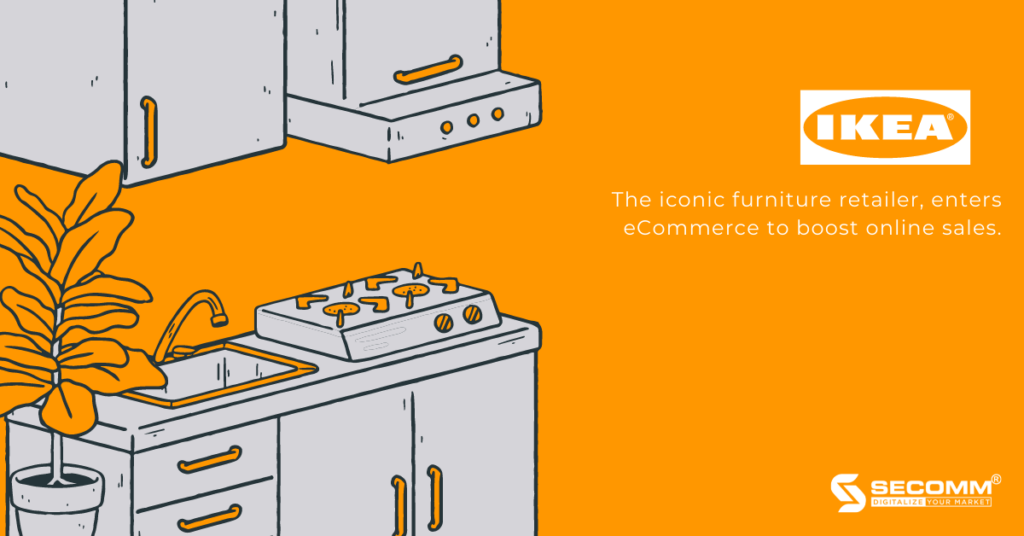
IKEA, or Ingvar Kamprad Elmtaryd Agunnaryd, is the world’s largest furniture retail enterprise and specializes in delivering minimalist-styled assembled furniture, household appliances, and accessories.
IKEA was established in 1943 in Sweden by Ingvar Kamprad, who started his business at the age of 17. IKEA swiftly gained global dominance with 392 locations across 48 nations.
With the goal of offering furniture with a lovely style and wide application while keeping the price low so that as many people as possible can purchase the goods. The majority of the departments, from marketing and sales to supply chain and warehouse, share this goal.
Everybody works together to keep IKEA’s “vital” competitive edge intact so that the company can publish catalogs with thousands of products offered at long-term stable prices.
Despite being the largest furniture retailer in the world, IKEA has lagged behind eCommerce trends, according to the Financial Times. This well-known retailer started “renovating” its sales technique only when it encountered numerous internet rivals.
The biggest barrier that makes it difficult for IKEA to adjust its previously successful business model is the maze-like arrangement of store layouts to create an engaging experience of sightseeing, interior shopping, or requiring customers to drive to the store and assemble the components to make their own furniture.
But IKEA has unimaginably succeeded in launching an e-commerce website by fusing cutting-edge technology with a well-organized marketing plan. In particular, IKEA specifically uses VR/AR technology, which is seen as a new eCommerce trend and is favored by many firms, to improve users’ online purchasing experiences.
IKEA thereby covers the sales void left by the prior on-site furniture business model, but the gap won’t truly be felt until the Covid-19 pandemic and social separation restrictions are in place.
From this point, IKEA expands its consumer base both online and offline, and sales are progressively encouraged to increase significantly.
Additionally, IKEA’s eCommerce website incorporates Instagram posts of photographs of IKEA furniture goods that consumers customize, share, and tag with the hashtag #IKEA.
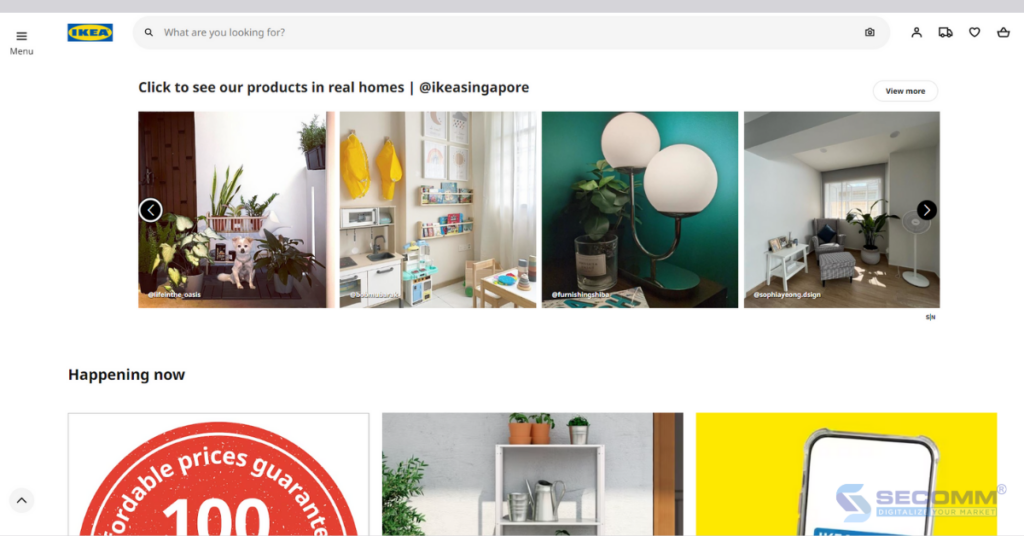
This not only helps this brand connect closely with Instagram users, increase its reputation and strengthen the loyalty of existing customers but above all, quick access to a large diverse customer base from the Internet in general and Instagram in particular thanks to the popularity and influence of this social network on young consumers.
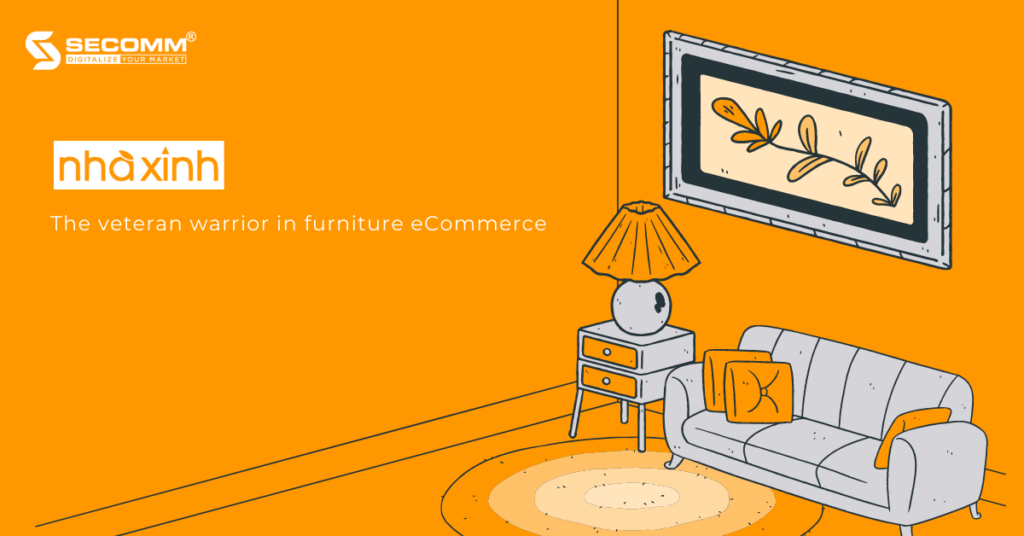
Established in 1999, Nha Xinh is a well-known furniture brand in Vietnam. It has two sizable showrooms, one each in Hanoi and Ho Chi Minh City.
As a manufacturer and supplier of living room, bedroom, dining room, and kitchen furniture with an Asian design aesthetic that favors coziness, friendliness, and simplicity above sophistication and luxury, Nha Xinh is a specialist in this field.
Nha Xinh’s website belonged to the “long-lived” row in the Vietnamese eCommerce village when it was created and launched in 2007, a period in which Vietnam was still getting used to utilizing the Internet to progressively integrate with the rest of the world.
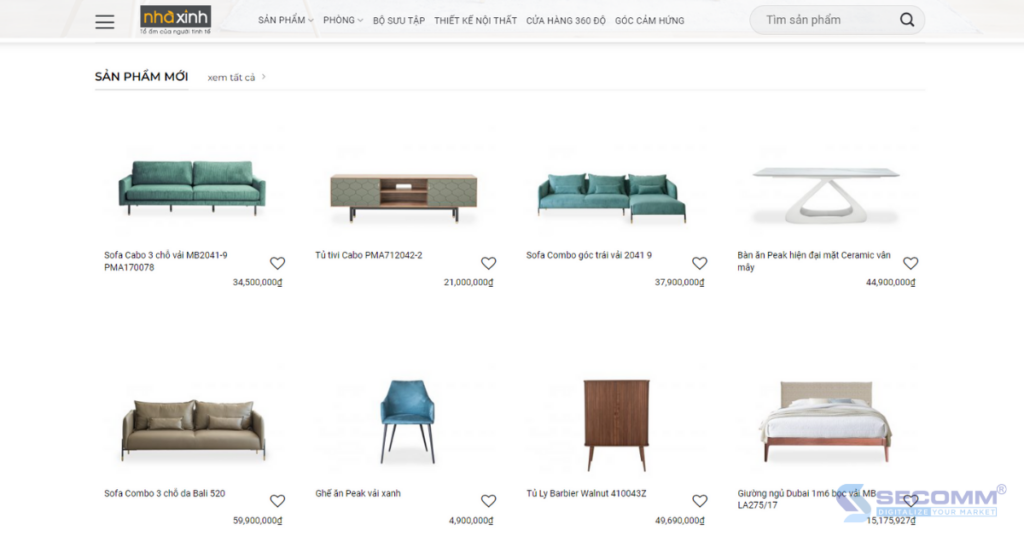
Nha Xinh’s eCommerce website has survived many years of market ups and downs while maintaining its inherent simplicity, intimacy, and sophistication.
Product categories are arranged clearly and harmoniously in each room to make it easy for customers to search, choose products that suit their needs, and get a sense of the room’s overall layout.
Customers can choose from a variety of options because the room’s layout is available with furniture and includes a detailed price. If they prefer, they can even select a combination of the interior and decor of the room without having to spend a lot of time figuring out how to combine each item because Nha Xinh already did it.
Additionally, Nha Xinh’s website has a unique section called “360-degree store” that uses 360-degree technology to let customers view the company’s interior products from a distance in an accurate manner from every nook and cranny of the room and every angle of the product, along with comprehensive information and price lists for each item.
Additionally, Nha Xinh’s “Inspiration Corner” catalog offers a wealth of thoughts and ideas to assist clients in designing their dream living space. Nha Xinh gives home design recommendations in a variety of styles, from elegant, and gentle to strong and personable depending on the individual’s preferences.
Therefore, Nha Xinh is more than just an eCommerce site that sells furniture; it is also a handbook that provides customers with never-ending design ideas.
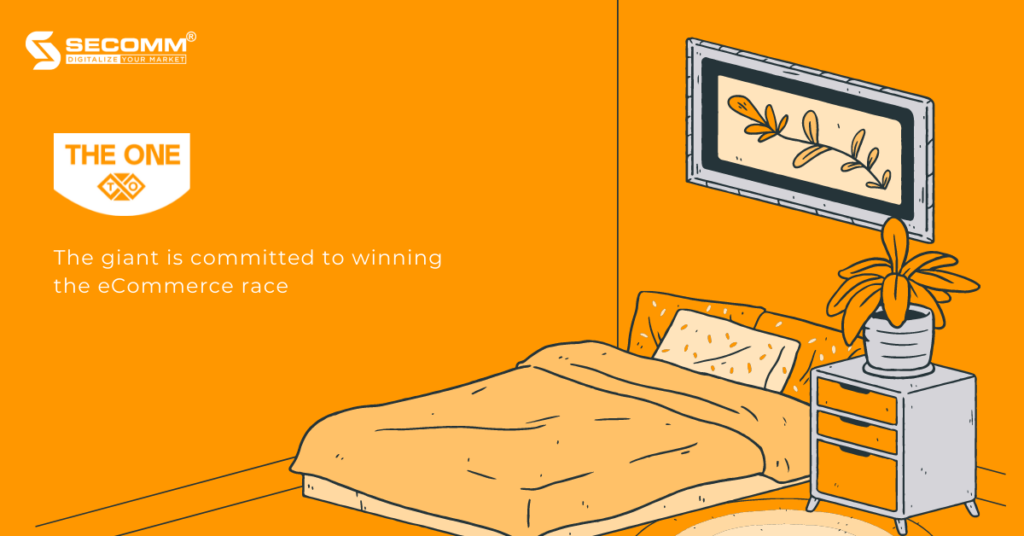
Hoa Phat Furniture was founded in 1995 and over the course of over three decades has made a positive impact on Vietnamese consumers’ perceptions of quality products and exquisite design while fulfilling a variety of needs for office furniture, home, household furniture, and medical furniture.
With a consistent growth rate of 20–25% each year, the brand is getting stronger and reaffirming its position as Vietnam’s top supplier and manufacturer of furniture.
When Hoa Phat Furniture changed its name to The One Furniture in the year 2022, it left a lasting impression on the industry. The brand name change is linked to adaptable changes in strategy. The company focuses on enhancing the stature, appearance, and image connected with the growth of the nation, helping to instill a variety of ideals into society.
Hoa Phat Furniture (now The One Furniture) invests extensively in technology infrastructure to streamline the production and supply process at the same time as it aspires to expand throughout the area and the world. One might say that The One Furniture has carried on the brand’s good core principles and improved upon them in order to better suit the current market trend.
One of Hoa Phat Furniture’s greatest successes to date is the effective use of 3D printing technology in production, which has helped the company create a number of new products like the Smart Safe; sofa and chair folding in the Italian style while also reducing production costs and speeding up prototyping and increasing product accuracy.
Hoa Phat Furniture concentrates on creating an eCommerce website to reach many potential clients that have a habit or preference for online buying, in addition to being adaptable and prompt with changes in strategy.
The firm creates websites using the WooCommerce framework, a well-known and dependable open-source platform used by many companies to implement eCommerce.
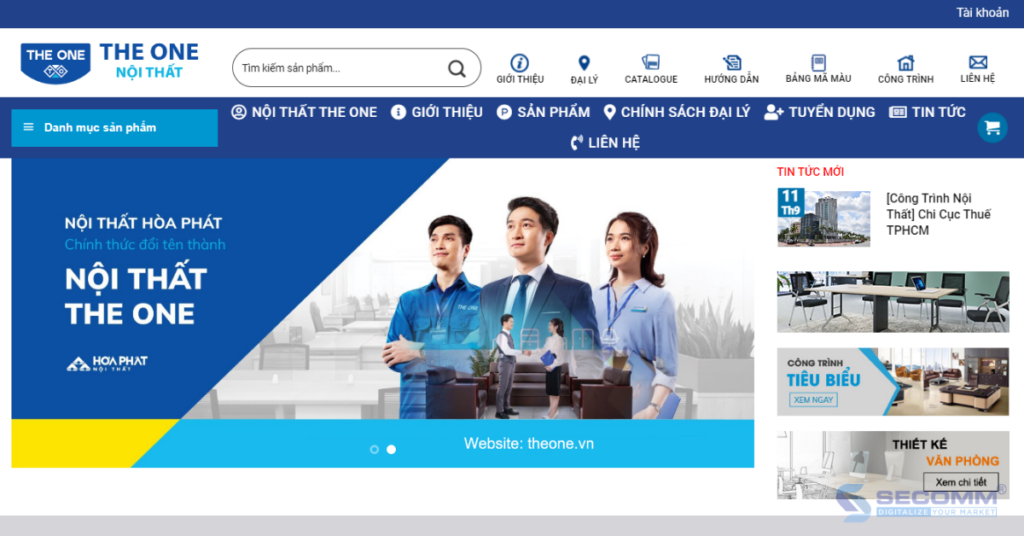
Compared to the previous version of Hoa Phat Furniture, The One Furniture’s new website (noithattheone.com.vn) features a more simplified, gorgeous, and contemporary interface (noithathoaphat.com.vn).
Additionally, the business supports the growth of well-known social media platforms like Facebook, Instagram, Youtube, and TikTok to broaden brand awareness, attract more customers, and enhance coverage.
Plus, the business offers a wide range of shipping and payment choices to accommodate the various needs of clients, making online buying at The One Furniture or Hoa Phat Furniture as convenient as it can be.
It is clear that the growth of the furniture market has been hastened by the speed at which eCommerce is developing.
Today, numerous local and international furniture companies participate in and offer the greatest shopping experiences to customers through the effective implementation of an eCommerce website, including IKEA (Sweden), Nha Xinh, and Hoa Phat Furniture (Vietnam).
From there, companies may quickly connect with a wider pool of Internet users and generate conversions through efficient marketing strategies.
However, business leaders need to carefully and comprehensively take into account the growing customer expectations and rapidly shifting market trends, not to mention specifically describe a systematic and precise business strategy for taking the most advantageous actions in the short and long term.
Completing that difficult task will take a lot of time and resources. As a result, many furniture companies opt for a more straightforward approach to the issue, enlisting the assistance of a highly qualified and dependable unit.
SECOMM has many years of expertise in effectively executing eCommerce for numerous customers in various countries. We specialize in offering free consultation services with qualified eCommerce implementation solutions.
Contact us right away for free counsel and assistance.
 2
2
 4,695
4,695
 0
0
 1
1Subscribe to get the latest eBook!
Hotline